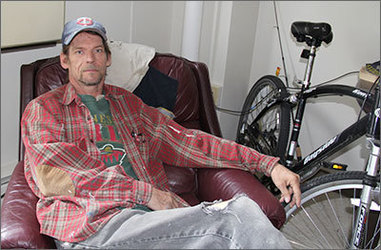 Ron
is a Hennepin Health member who lives in an interim housing unit that
Hennepin Health is leasing from the Minneapolis Public Housing Authority. This interim
housing project is funded through Hennepin Health’s reinvestment
initiative
funds. To be eligible for the project, a Hennepin Health member must be
homeless — and either in inpatient care or recently discharged from inpatient care — with
high risk for hospital readmission due to lack of housing and social supports.
The
project provides select Hennepin Health members with as many as 90 days of housing in an
individual, studio apartment in the Elliot Twins Building in Minneapolis’
Elliot Park neighborhood. While housed, members
receive in-home nursing and/or case management supports to meet their medical
and mental health needs. The Hennepin Health social services navigation team
also assesses members' housing needs and helps them secure supportive
housing placements after their stay in Elliot Twins.
Here's Ron’s story:
Ron’s
symptoms began in November 2012: dizziness, impaired vision, lethargy, weight
loss, and thirst.
The
55-year-old had the sense that something was wrong. But he didn’t go to the
doctor right away.
Ron’s
familiar with pain. He’s done construction and janitorial-type work most of his
life and it’s entailed plenty of physical discomfort. Maybe that’s why he
toughed it out initially. But after three months, he’d had enough and he made
an appointment at Hennepin County Medical Center’s Brooklyn Center Clinic.
The
day of that appointment — February 25, 2013 — is now seared in his mind. That
Monday, Ron recounted his symptoms to a physician and she ordered lab work.
Before he left, technicians took samples of Ron’s blood and urine.
That
night, at 8:56 p.m., Ron was home, preparing for bed, when he received a phone
call from his doctor. She told him his lab results were abnormal. His blood
sugar levels were off the charts. She told him he needed to go to the emergency
room immediately; if he went to sleep he might not wake up.
Ron
describes it this way: “God was in the Brooklyn Center Clinic at nine o’clock
that night.”
The diagnosis
Ron
was diagnosed with latent autoimmune diabetes of adults (LADA), also known as slow
onset type 1 diabetes and diabetes type 1.5. LADA is a subset of diabetes that
progresses slower than type 1; many patients don’t develop it until they’re in
their thirties or older.
 Since his diagnosis, Ron carries this backpack with him everywhere. The backpack contains gummy bears and other food that he can eat if his blood sugar levels suddenly plunge.
Though
there’s a diagnosis, Ron’s case continues to dumbfound physicians. For
instance, despite his disease, many of his health metrics — like weight, cholesterol,
and blood pressure — remain stellar. And, although diabetics may experience
large blood sugar fluctuations, Ron’s are particularly extreme. For instance,
on June 1, 2013 (according to medical paperwork he showed us), his blood sugar
oscillated between 36 and 586 mg/dl in a single day. And while sitting in his apartment
with us on June 2, 2014, his glucose monitor registered 397 mg/dl. To put that
in perspective, The American Diabetes Association recommends that a person’s
blood sugar levels be between 70 to 130 mg/dl when fasting and less than 180
mg/dl after eating a meal.
Ron
recalls a day when he went to get his levels tested. “When [the technicians]
pricked my finger, they asked me why my hands were dirty,” he says. When he
explained it was because he’d been at work all day, no one believed him, because
his readings were so far outside the norm.
Life as a diabetic
Because
he has an “extreme” fear of needles, Ron says that pricking his skin to test
his blood sugar level is particularly difficult. He dreads the mornings because
“the first thing I have to do [when I wake up] is be uncomfortable.”
But
that’s not the half of it.
Shortly
after being diagnosed last year, Ron lost the job he’d held for nine and a half
years. He says his boss saw him trembling as he came down a ladder and deemed
it too dangerous for him to continue working. (Although Ron has been able to
find other jobs, it’s been a challenge to gain rapport with employers because
he can’t always commit to eight- to ten-hour workdays as before, and he usually
doesn’t know until the morning if he’ll feel well enough to come into work. As
he’s discovered, “Who is going to hire me when I have to take time off?”)
After
his diagnosis, Ron’s condition worsened and in the summer of 2013, he
experienced a diabetic coma.
His
unemployment benefits finally ran out.
And
on September 15, 2013, he became homeless.
Homelessness and
Hennepin Health
While
he was homeless, Ron lived with friends and at the Salvation Army.
Kim
Evers — a certified diabetes educator at Hennepin County Medical Center’s Whittier Clinic — has worked with
Ron. While he was homeless, Evers witnessed Ron’s health deteriorating and she attributes
his homelessness to some of that deterioration.
More
broadly, Evers believes that poor health and homelessness is a “vicious cycle”
with both factors influencing the other. That is, Ron’s homelessness
contributed to his poor health and his poor health contributed to his
homelessness.
Why
is homelessness so challenging for people with medical concerns? Evers weighs
in, from a diabetic standpoint:
- Nutrition
is paramount for a diabetic, but the food that is most accessible in shelters
and on the streets is often highly processed and sugar-laden, devoid of
nutrition.
- Insulin
needs to be kept cold to prevent spoiling, but homeless people may not have
access to a refrigerator.
- It’s
important for diabetics to maintain a regular meal schedule, but this may be
difficult to do when a person is transient.
- Diabetics
may get tired easily and need to rest, but some shelters require people to
vacate during the day and it may be unsafe or unfeasible to sleep on the
streets.
- Homeless
life is stressful. Stress hormones cause blood sugar levels to rise.
Many
health care experts and organizations are now acknowledging the
link between health and homelessness, Hennepin Health among them. In 2012, Hennepin
Health used some of its reinvestment initiative funds to rent out transitional
housing units in an apartment complex that is owned by the Minneapolis Public
Housing Authority.
As
detailed above, the contract specifies that Hennepin Health will prioritize members
who are homeless — and either in inpatient care or recently discharged from inpatient care —
with high risk for hospital readmission due to lack of housing and social
supports.
In
April, Evers contacted Neri Diaz, M.S.W, L.G.S.W, Whittier Clinic
senior social worker. Evers remembers
telling Diaz, “Ron just can’t be homeless any more. This is dangerous. We have
got to do more for him.” Diaz contacted Hennepin Health’s social services navigation team, asking that Ron be considered for a vacant unit in Elliot Twins.
Evers wrote a letter to Hennepin Health to document the medical necessity of
the housing support.
Ron
moved in on May 6.
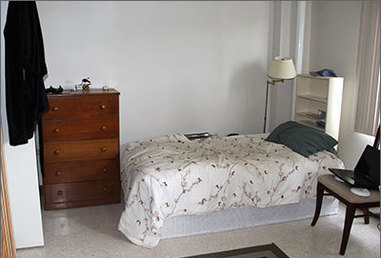 Ron's studio apartment at Elliot Twins
Since moving in
While he was homeless, Ron reveals that his diet — like the diets of so many people who experience homelessness — consisted almost entirely of inexpensive, highly processed food that was bought at convenience stores and fast-food restaurants or served at the shelter.
As a result, the meal he prepared on May 6 — in the kitchen of his studio apartment — was the first “home cooked meal” he’d eaten since September 15, the day he became homeless. Ron’s insulin is now refrigerated and he has been able to rest when he needs to. Since he has been housed, Ron has not been hospitalized.
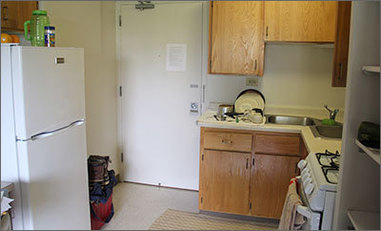 Ron's kitchen at Elliot Twins
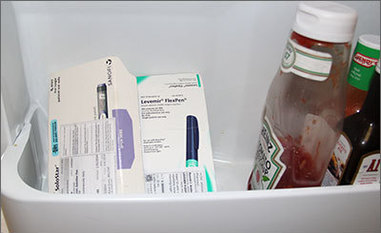 Ron's insulin, refrigerated
But
many challenges remain.
Ron
explains that he wakes up blind some days (a symptom of low blood sugar). He
has stage two kidney failure. He’s got neuropathy in his right foot and it’s
numb. And despite consulting with many doctors and taking the medications
prescribed him, he continues to experience extreme blood sugar fluctuations.
Ron
says that the housing Hennepin Health has provided him is “wonderful,” but
acknowledges that the road ahead is still a challenge. Hennepin Health believes
that housing is an important part of keeping members healthy and is currently
trying to secure long-term supportive housing for Ron.
Do
you know a Hennepin Health patient who might meet the criteria to participate
in the Minneapolis Public Housing Authority/Hennepin Health interim housing
project? If so, please contact Kim Nguyen, Hennepin Health social services supervisor, at Kim.Nguyen@hennepin.us
Back to top
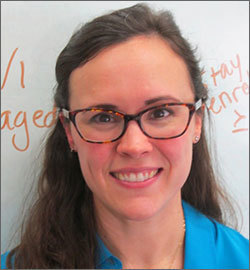 Katherine
Vickery, M.D., M.Sc. recently completed the Robert Wood Johnson Foundation Clinical Scholars Program and joined Hennepin
County Medical Center as a clinician-investigator in the Division of General
Medicine and Family Medicine. While in the Clinical Scholars Program, Vickery began conducting
research on Hennepin Health.
The two-year
Clinical Scholars Program gives physicians the opportunity to conduct research —
and to work with communities, organizations, practitioners, and policymakers —
on some of America’s most important health care issues.
Clinical scholars
complete a master’s degree at one of four institutions — the University of
California, Los Angeles; the University of Pennsylvania; Yale University; or
the University of Michigan. (Vickery studied at the latter.) They also have
supported time to focus on research projects. Vickery’s research will analyze
how Hennepin Health has impacted the health care and the lives of its members.
The Start
Vickery
first heard about Hennepin Health from Kate Neuhausen, a physician friend and
co-clinical scholar. Neuhausen had written a profile on Hennepin County Medical Center’s Coordinated
Care Center
and had met Jennifer DeCubellis, assistant county administrator, at
a conference in Washington D.C. Intrigued, Vickery reached out to DeCubellis
and Ross Owen, Hennepin Health deputy director, and together they developed a
research proposal.
Giselle Corbie-Smith,
Vickery’s National Advisory Council (NAC) mentor through the Clinical Scholars
Program — a renowned professor
at the University of North Carolina-Chapel Hill — was also
encouraging. Corbie-Smith completed a visiting professorship at Hennepin County
Medical Center and has spent her career trying to eliminate health care
disparities; she told Vickery that working with Hennepin Health would put her “at
the cutting edge of the cutting edge” of health care reform.
The Research
Vickery’s research
consists of two projects. The first will compare health care utilization and
cost of Hennepin Health enrollees to other, similar Medicaid patients in
Hennepin and Ramsey counties. The control group will consist of Ramsey county
Medicaid patients who met eligibility criteria for Hennepin Health but could
not enroll because they live in a different county. This project uses Medicaid
claims data from the Minnesota Department of Human Services.
The second
project will use interviews with patients and providers — along with claims
data — to determine which individuals seem to benefit the most from Hennepin
Health and why.
Vickery is in
the final stages of data validation and cleaning and in the early stages of
analyses. She expects preliminary results this summer.
A team of
Hennepin Health partners have supported Vickery in conducting this work including
Ross Owen, M.P.A., Hennepin Health deputy director, and from Hennepin County
Medical Center: Dana Soderlund, M.P.H., Hennepin Health data analyst; Scott
Shimotsu, PhD, senior health care data analyst; Mark Linzer, M.D. director of
the Division of General Internal Medicine; Pam Clifford, R.N., M.P.H. director
of the Center for Health Care Innovation; and Nancy Garrett, PhD, chief
analytics officer.
Future Work
Earlier this
year, Vickery learned that she is going to stay at Hennepin County Medical
Center beyond her Robert Wood Johnson fellowship; she was hired as a clinician-investigator
with a primary appointment in internal medicine and a secondary appointment in family
medicine. The new role, which starts this month, is 75 percent research and 25
percent clinical. In her clinical capacity, Vickery will practice out of
the Coordinated Care Center.
In addition
to her other responsibilities, Vickery chairs Hennepin Health’s newly-founded Research
and Publications Committee. In its first months, the committee created a
repository of scholarly and non-scholarly publications about Hennepin
Health. The committee also provides oversight for research and publications
efforts that are in-progress and fields ideas for future endeavors.
Back to top
 A sampling of NorthPoint staff. From left to right: Steve Wilson, Anisa Kovacevic, Paul Erickson, Catherine McCoy, Lanette Howze, Pa Yang, Hugo Trejo, and Carla Lucas
In January, NorthPoint initiated an outreach and
care coordination program that was funded as a Hennepin Health reinvestment
initiative. Through the program, NorthPoint has hired additional outreach and
care coordination staff to connect unengaged Hennepin Health members to primary
care, dental care, and more. As part of this initiative, NorthPoint holds a
group visit each
Thursday from 1:30 to 3:30 p.m. Typically, five to 10 people attend. The group
visit is an opportunity for people to learn about Hennepin Health services,
meet NorthPoint staff, receive a consultation from a physician, get same-day
access to dental and behavioral health appointments, and more.
Inside a NorthPoint group
visit
On
a Thursday in early April, it’s raining and the group visit turnout — four
people — is lower than normal. After an intake, patients are funneled into a
conference room where a table is covered in sandwiches and fruit; NorthPoint
hopes that the food (and a small-denomination gift card that is given to
patients at the end of their visit) will motivate people to attend. People eat
while they wait for Dr. Paul Erickson to give an orientation.
NorthPoint’s
medical director since 2006, Erickson feels an affinity to North Minneapolis;
he grew up less than a mile from NorthPoint near the intersection of Penn and
Glenwood avenues.
When
Erickson arrives, he explains that NorthPoint has been a fixture in north
Minneapolis since 1967. Formally known as Pilot City, the Federally Qualified
Health Center
(FQHC) was one of 13 original neighborhood service programs (NSPs) started
across the country as part of President Johnson’s war on poverty. NSPs were
designed to be multi-purpose centers, places where low-income and
disenfranchised people could receive health and human services.
Erickson
summarizes the myriad of services available at NorthPoint. There’s dental,
laboratory, pharmacy, optometry, radiology, nutritional, housing, financial,
medical, and behavioral health services (to name a few). There are resources
for people who are struggling with chemical dependency and domestic violence.
There’s even a food shelf and a computer lab in the facility.
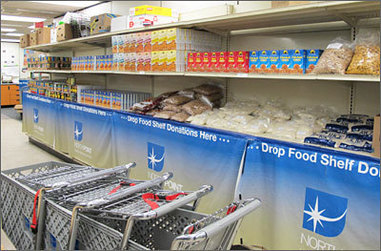 The NorthPoint food shelf stocks emergency food packages, monthly food supplies, baby food, diapers, fresh produce, and miscellaneous non-food items.
“We
really believe in primary care at NorthPoint,” Erickson says. Getting regular
primary care can “make you healthy.”
“I’m
46 and I’ve never had a ‘regular doctor,’” admits a patient.
Erickson
encourages everyone to establish a primary care provider, even if they’ve never
had one before.
“But
what if I don’t have a way to get to my appointments?” asks another.
Erickson
explains that Hennepin Health offers its patients single-ride bus passes to get
to their medical appointments. As of March 1, 2014, Hennepin Health patients
who have four or more medical appointments per month are eligible for a 31-day
Metro Transit bus pass, which they can pick up at Metropolitan Health Plan.
Then
Erickson runs through some of the things a person can do to stay healthy. There
are preventive screenings — breast, cervical, colon, and prostate. There are
immunizations. There are checks for cholesterol, blood pressure, and blood
sugar. And then there’s exercise.
“I’ve
been a doctor for 30 years, and if I could prescribe one thing it would be
exercise,” Erickson says. He asks everyone to describe his or her workout
regimen.
One
patient looks embarrassed when he admits that he doesn’t exercise. “But I use
public transportation, so I’m always jumping on and off buses,” he says.
“Sometimes
when I’m on the bus I’ll pull the [stop request] buzzer two or three blocks
early and walk,” Erickson replies. “Walking is underrated.”
Another
patient is more serious about working out. “I find that the only way to be
successful with exercise is to put it on your calendar like an appointment,”
she tells the group.
After
Erickson leaves, patients receive briefings about different NorthPoint service
areas. Kristy Singlestad, B.A., NorthPoint dietician, has brought props, including small
bags of sugar and fake food.
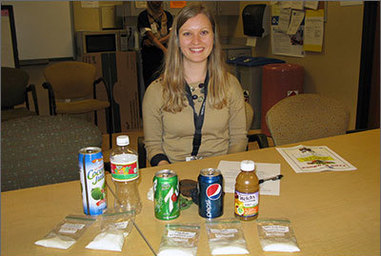 Kristy Singlestad
Using
the bags, Singlestad shows patients how many teaspoons of sugar are in Pepsi
and other beverages. Using the fake food, Singlestad demonstrates the
composition of a healthy meal plate, explaining that it should contain
approximately 50 percent produce. She then tells patients about an opportunity
to put more produce on their plates: starting May 16 (and continuing through
September 19), NorthPoint will be distributing free fruit and vegetables in its
parking lot at 1315 Penn Avenue North every other Friday from 9 a.m. to noon.
(Those dates are May 16 and 30; June 6 and 20; July 18; August 1, 15 and 29;
and September 5 and 19. For more information, or to volunteer, call
612-767-9162.)
After
Singlestad’s presentation, other staff explain NorthPoint’s dental services,
community health workers, and behavioral health services.
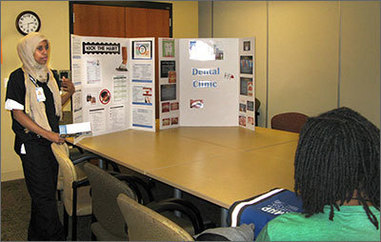 Ifrah Rashad, NorthPoint dental assistant, gives a presentation to Hennepin Health members
Afterward,
every patient gets a one-on-one consultation with Erickson. They can also have
an on-the-spot dental or behavioral health appointment. (Services available at
the dental appointment include cleanings, screenings, and X-rays.) There's also the opportunity to schedule a primary care or other type of appointment.
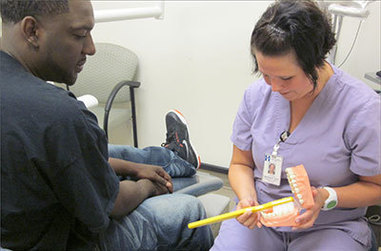 Stephanie Valek, NorthPoint dental hygienist, teaches a Hennepin Health member about oral hygiene
Community outreach —
connecting people to group visits and more
Lanette Howze and Steve Wilson are community health workers who
were hired through NorthPoint’s reinvestment initiative.
Howze and Wilson do much of their work outside the clinic,
finding unengaged people and connecting them to primary care, dental care, and
more. According to Wilson: "We walk along Broadway Avenue and Lyndale
Avenue, we talk to everyone, we go into places like McDonald’s, Footlocker,
Bojangles’, probation offices, parks, and shelters."
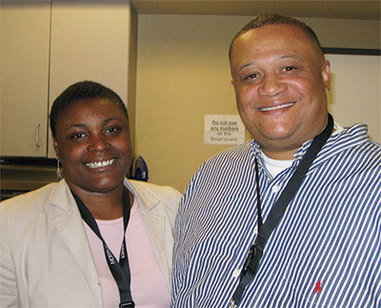 Lanette Howze and Steve Wilson
Another component of their outreach is establishing
relationships with humanitarian organizations in the Twin Cities. Some of the
organizations they’ve connected with include Youth Link, Turning Point, Sharing and Caring Hands, and StreetWorks Outreach Collaborative.
Wilson describes his work as “developing an infrastructure of
referrals, of people and organizations that know about [NorthPoint and Hennepin
Health].”
Howze and Wilson bring a wealth of experience to their jobs.
Wilson has been doing street outreach for over 10 years with organizations like
The Bridge for Runaway Youth, Lutheran Social Services, and the YMCA. Howze has
a more clinical background: she’s worked at Cedar Riverside Clinic and is
knowledgeable about Epic (the electronic health record used by Hennepin
Health). Julie
Knudsen, R.N., NorthPoint health care home and care coordination supervisor, notes that their different areas of expertise make them
a “great team.”
Outcomes
Before
NorthPoint initiated the group visit model, there were two ways to be seen by a
provider: make an appointment or walk into the clinic. (The latter is not
always reliable.). The group visit model offers patients a third way to access
care.
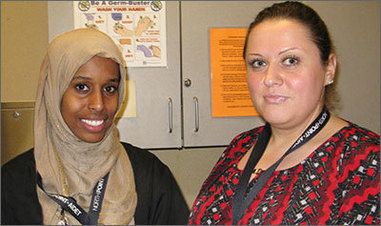 Ifrah Rashid (left) and Anisa Kovacevic, NorthPoint community health worker, have both contributed to NorthPoint's reinvestment initiative success.
As
of June 1, 2014, NorthPoint had engaged 246 Hennepin Health patients through
their reinvestment initiative. This is 44 percent of their annual engagement
goal of 557 patients.
Here
are some other outcomes:
- 132
patients newly engaged via NorthPoint’s dental clinic (54 percent of their annual goal)
- Nine Rule 25 Assessments completed for chemical dependency treatment
- 68
outreach events/sessions completed
- 1,234
encounter tallies via outreach events/sessions
- 92
integrated group visits completed
- 64
medical long visits (30 minutes or longer) completed with a medical provider
- 248
internal referrals made across the campus as a result of NorthPoint’s
integrated services model
In
November 2014, Hennepin Health will evaluate NorthPoint’s reinvestment
initiative on process measurements like the number of completed referrals and
Rule 25 Assessments. Hennepin Health will also look at the pre- and post-primary
care and emergency department utilization rates of patients engaged via the
initiative.
Back to top
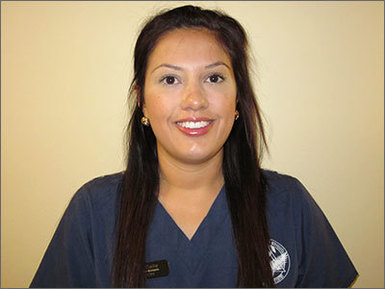 Sylvia Cuellar, D.D.S., NorthPoint dentist
NorthPoint is holding a Hennepin Health member event on
Tuesday, June 24 through Thursday, June 26 from 8 a.m. to 3:30 p.m. on all
three days. Participants will receive a dental exam, medical screening,
behavioral health screening, complimentary refreshments, gift bag, resource
information, and more. Hennepin Health members should call NorthPoint at
612-543-2500 to RSVP. Walk-ins are welcome, too.
Back to top
|